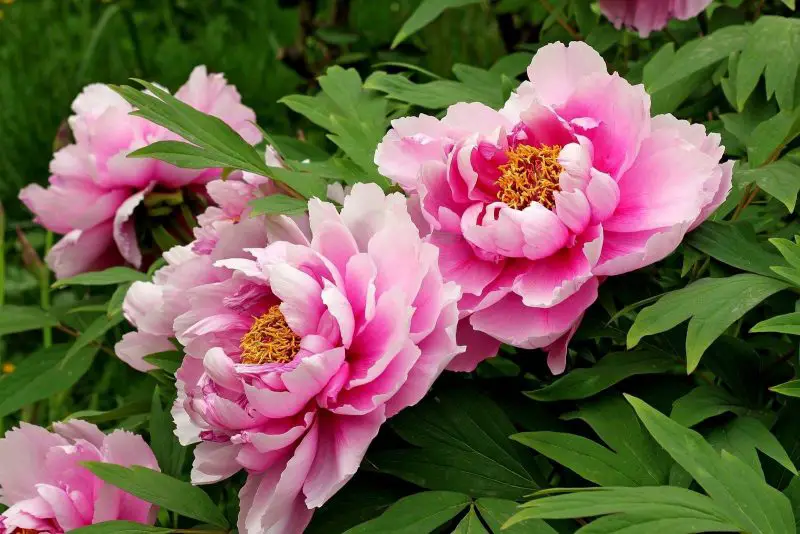Peonies are timeless garden treasures, admired for their lush blooms, rich fragrance, and ability to thrive for decades. Their elegance transforms gardens into vibrant landscapes each spring, creating a sense of grace and permanence. For gardeners, learning how to propagate peonies is not only rewarding but also essential for expanding these beloved plants. Propagation allows you to share their beauty, fill your garden with new life, and preserve rare or heirloom varieties that hold sentimental value. Each new plant continues the legacy of the original, offering endless blooms and color for years to come.
Propagating peonies may sound complicated, but with patience and the right methods, it becomes a simple and enjoyable process. Whether you’re dividing roots, growing from seeds, or taking cuttings, understanding each step ensures lasting success. Proper timing, soil preparation, and aftercare determine how strong and healthy your new plants will become. Once established, propagated peonies reward you with abundant flowers and minimal maintenance. This complete guide reveals the easiest, most effective ways to propagate peonies—helping you grow them beautifully, naturally, and successfully for a lifetime.
Understanding Peony Growth and Propagation Basics

To propagate peonies successfully, you first need to understand how they grow. Peonies follow a natural rhythm that repeats every year, and each stage influences propagation success. In spring, red or pink shoots emerge from the soil, turning green as they mature. These shoots develop strong stems and lush leaves that collect energy from sunlight. The plant stores that energy in its thick, fleshy roots, which serve as its foundation. Healthy roots mean healthy plants. Knowing when the plant is most active or resting helps you choose the right time to divide or cut it for propagation.
During summer, peonies reach full bloom and then shift focus from flowering to root development. After the blossoms fade, the plant’s energy moves downward into the root system. This is when the plant begins preparing for next year’s growth. Propagating too early, while the plant is still flowering, can cause stress and weak growth. The best time to propagate peonies is in late summer or early fall when the plant starts to enter dormancy. At this point, the roots are full of nutrients and ready to adapt to new conditions. Proper timing ensures strong divisions and better survival rates.
Propagation doesn’t just multiply your plants—it rejuvenates them. Mature peonies that have stopped blooming as vigorously benefit from division. Separating the root clumps allows each section to grow freely with renewed strength. Understanding the plant’s growth cycle, root structure, and energy flow gives you a clear advantage. With this knowledge, you can propagate peonies confidently, knowing that each new plant will carry the same beauty, fragrance, and resilience as the original.
The Best Time to Propagate Peonies
Timing determines whether your propagation will succeed or fail. Peonies respond best to propagation during their dormancy period, which usually occurs in late summer through early fall. By this time, the flowers have faded and the plant has redirected its energy into the roots. The leaves begin to yellow, signaling that photosynthesis is slowing down. This period allows the plant to rest and recover while maintaining active roots underground. Dividing or cutting at this moment minimizes stress and ensures quick adaptation to new soil conditions. Propagation during dormancy helps the roots establish before the ground freezes.
Attempting propagation in spring often leads to weak plants. During this period, peonies use most of their strength to push out new shoots and prepare for blooming. Dividing them then interrupts their energy flow and delays flower production. Some gardeners try propagating right after flowering, but the plant still needs its foliage to feed the roots. Late summer to early fall remains ideal because the roots are rich in nutrients, and the plant is naturally slowing down. Working within this natural rhythm gives you stronger, more resilient plants that bloom reliably each year.
Climate also affects the best time for propagation. In colder regions, late August to early September works best, giving roots time to settle before frost. In warmer zones, propagation can extend into mid or late autumn since the soil remains workable longer. Always aim to finish propagation six weeks before hard frost arrives. This window ensures the new divisions grow feeder roots that support them through winter. When timed correctly, peony propagation becomes effortless, setting the stage for years of growth and colorful blooms.
Propagating Peonies by Division
Dividing peonies is the most reliable and effective way to propagate them, especially for older plants that have stopped blooming as vigorously. This method rejuvenates mature clumps and creates new, healthy plants that maintain the same traits as the parent. The best time to divide is late summer or early fall, when the plant begins dormancy but before the ground freezes. A day before dividing, water the soil well to soften it. Use a sharp spade or garden fork to dig a wide circle around the plant, keeping about twelve inches away from the crown. Lift the root ball carefully, preserving as many thick roots as possible. Gentle handling prevents injury to the fleshy, brittle roots that store the plant’s energy.
Once removed, gently shake off or wash away excess soil so you can see the roots clearly. Look for firm, light-colored roots with visible buds, called eyes, near the crown. Each eye will produce a new stem the following spring. Using a clean, sharp knife, divide the root mass into sections, ensuring each piece contains at least three to five eyes and several healthy roots. Avoid small or weak sections since they take years to bloom. Let the divided roots rest in a shaded spot for a few hours so the cut surfaces can dry and callus, which reduces the risk of rot.
Replant divisions immediately in a prepared bed with loose, fertile soil. Set each crown so the eyes are no more than two inches below the surface. Planting too deep delays blooming, while shallow planting exposes the buds to frost. Water thoroughly after planting to help the soil settle around the roots, then apply a light mulch layer to retain moisture. Dividing not only multiplies your peonies but also extends their life, giving your garden lasting beauty and consistent blooms.
How to Propagate Peonies from Seeds
Propagating peonies from seeds is a slower but deeply rewarding process for gardeners who enjoy patience and discovery. Unlike division, which produces clones of the parent plant, growing from seed can create entirely new varieties. This method works best for those seeking to experiment with hybridization or preserve rare species. Collect mature seeds from healthy plants in late summer or early fall once the seed pods begin to crack open. The seeds should be dark, firm, and smooth. Peony seeds require a period of cold stratification to germinate properly, mimicking natural winter conditions that break dormancy. Without this cold treatment, most seeds remain inactive.
To prepare them, place the seeds in moist sand, peat, or paper towels inside a plastic bag. Keep the bag at room temperature for about two months, then transfer it to a refrigerator for another three months. During this time, monitor the moisture level to prevent drying. After the cold period, sow the seeds about an inch deep in pots filled with a mixture of garden soil and compost. Maintain consistent moisture and place the pots in a bright but shaded location. Germination may take several months, and young seedlings usually emerge in spring. Keep them protected from harsh weather and water gently until they develop strong roots.
Once the seedlings grow several inches tall, transplant them into the garden or larger containers. Space them generously to allow airflow and prevent disease. Peonies grown from seed take time to mature—often five to seven years before flowering—but the result is worth the wait. Each bloom may differ slightly from the parent, offering unique colors and petal forms. This slow yet fascinating method allows gardeners to create new generations of peonies that carry both strength and originality, adding lasting charm to any landscape.
How to Propagate Peonies from Cuttings
Propagating peonies from cuttings is less common but can be successful with the right care and patience. This method works best with tree peonies, which have woody stems that can produce roots when treated correctly. The ideal time to take cuttings is in early summer when the stems are firm but not yet mature. Choose healthy, disease-free stems with at least one leaf node. Cut a section about four to six inches long using sterilized pruning shears. Remove the lower leaves, keeping only one or two at the top to reduce moisture loss. Treat the cut end with rooting hormone to encourage faster root development.
Prepare a pot with a well-draining mix of garden soil, compost, and coarse sand. Insert the cutting about two inches deep, ensuring the node is buried. Water gently to settle the soil, and cover the pot with a clear plastic bag to create a humid environment. Place it in a bright location with indirect sunlight. Keep the soil consistently moist but never soggy. In about eight to twelve weeks, roots should begin forming. You can check by gently tugging on the stem—if it resists, roots have developed. Remove the plastic cover gradually to help the cutting adjust to open air.
Once strong roots form, transplant the young peony into a larger container or directly into the garden. Choose a spot with rich, well-drained soil and full sun exposure. Water regularly and protect the young plant from extreme temperatures. Peonies propagated from cuttings may take several years to flower, but once established, they develop into robust, long-lived plants. This method requires dedication but allows gardeners to expand their collection while preserving the unique beauty of tree peonies.
Preparing Soil and Choosing the Right Location
Proper soil preparation and site selection determine how well your propagated peonies will grow. Peonies prefer fertile, well-drained soil that remains slightly moist but never soggy. The best soil type is loamy with plenty of organic matter, allowing air and water to move freely through the roots. Begin by loosening the soil to a depth of about eighteen inches. Mix in compost or aged manure to enrich the ground with nutrients. If your garden has clay soil, improve drainage by adding coarse sand or fine gravel. Good drainage prevents water from pooling around the crown, which can lead to rot. Healthy, aerated soil creates the best foundation for vigorous growth.
Choosing the right location is equally important. Peonies thrive in full sunlight and need at least six hours of direct sun each day. A bright, open area allows the plant to develop strong stems and large blooms. Avoid spots with too much shade, as this encourages weak growth and fewer flowers. Also, choose a site protected from strong winds that can damage delicate blossoms. Tree peonies benefit from light afternoon shade, especially in hot climates, while herbaceous varieties love full sun. Once you select the right location, your peonies will reward you with healthy leaves, long-lasting blooms, and strong root systems.
Before planting your propagated divisions, seeds, or cuttings, test the soil’s pH level. Peonies prefer slightly acidic to neutral conditions, between 6.5 and 7.0. Adjust the pH by adding lime to raise it or sulfur to lower it. Water the soil thoroughly before planting to help it settle. Proper preparation ensures that new peonies establish quickly, absorb nutrients efficiently, and grow into thriving plants that bloom beautifully year after year.
Caring for Newly Propagated Peonies
Watering and Moisture Control
Newly propagated peonies require consistent moisture to establish strong roots, but overwatering can cause rot. After planting, water deeply so the soil settles around the roots. Check the top two inches of soil regularly—if it feels dry, water again. Always water at the base rather than overhead to keep foliage dry and prevent fungal problems. Early morning watering allows leaves and soil to dry throughout the day, reducing disease risk. Proper watering supports root expansion and ensures your peonies stay hydrated without becoming waterlogged.
As roots strengthen, reduce watering frequency while maintaining steady soil moisture. Avoid shallow, frequent watering, as it encourages weak root systems. During dry spells, add mulch to lock in moisture and keep soil temperature stable. Organic mulch like straw, shredded bark, or compost works best for young peonies. Keep it at least one inch away from the crown to prevent rot. Balanced watering builds drought-resistant roots and supports healthy, vigorous growth in the first few years after propagation.
Fertilizing and Feeding
Fertilizing young peonies should be careful, gradual, and well-timed. Avoid applying fertilizer right after propagation because new roots are delicate and still healing. Wait until you see new shoots emerging, usually in early spring, before feeding the plant. At that stage, use a balanced, slow-release fertilizer such as 10-10-10 or a light compost mix. Spread it evenly around the base of the plant, keeping at least four inches away from the crown to prevent burning the roots. Always water after fertilizing to help nutrients absorb into the soil evenly. Proper timing ensures the plant can use nutrients efficiently without stress.
As the peony matures, feed it once more after blooming to restore strength for the next growing season. Choose organic compost, aged manure, or bone meal for a gentle, natural boost. Avoid heavy nitrogen fertilizers, which promote leaf growth but reduce flower production. For sandy soils, add compost annually to improve texture and retain nutrients. Fertilizing once or twice a year is usually enough, as peonies prefer moderate feeding. Too much fertilizer leads to soft stems and fewer blooms. Consistent, balanced nourishment helps young propagated peonies grow into strong, vibrant plants with deep roots and large, lasting blossoms.
Sunlight and Temperature Needs
Sunlight plays a crucial role in helping newly propagated peonies grow strong and flower well. Peonies need at least six hours of direct sunlight each day to develop healthy foliage and abundant blooms. Choose a spot with full morning sun and light afternoon shade, especially in warmer regions. Too much shade results in weak stems and fewer flowers, while intense, direct sunlight all day can scorch young leaves. Balanced light exposure ensures steady photosynthesis and promotes strong root energy. Tree peonies appreciate partial shade in hot climates, while herbaceous varieties thrive in bright, open areas.
Temperature control is equally important during the establishment phase. Peonies prefer cooler conditions, typically between 60°F and 70°F. Avoid exposing young plants to extreme heat or frost while they are still adapting. During hot weather, keep the soil cool and moist by watering early in the morning. In colder regions, cover the soil lightly with mulch to insulate the roots and prevent temperature shocks. Proper light and temperature management allow young peonies to grow steadily, forming thick stems and vibrant leaves that prepare them for successful flowering in future seasons.
Mulching and Winter Protection
Mulching offers essential protection for young peonies during their first winters. After the ground begins to cool, spread a layer of organic mulch such as straw, shredded bark, or dry leaves around the base of each plant. This layer helps regulate soil temperature, conserves moisture, and shields the crown from frost. Keep the mulch about two inches thick and at least one inch away from the crown to prevent rot. Mulching also suppresses weeds that compete for water and nutrients, allowing the plant to focus on establishing roots.
In colder climates, increase the mulch layer to four inches for extra insulation during freezing nights. Avoid using heavy materials like wet grass or thick compost, which retain too much moisture. When spring arrives, gradually remove the mulch as temperatures rise and new shoots appear. Exposing the crown too early can lead to frost damage, so watch the weather closely. Consistent winter protection ensures that young peonies survive the cold months unscathed, awakening in spring with renewed strength and ready to produce lush, colorful blooms.
Common Problems During Peony Propagation
Root Rot and Poor Drainage
Root rot is one of the most common problems faced when propagating peonies, especially in gardens with heavy clay or compacted soil. This condition occurs when water accumulates around the roots for too long, depriving them of oxygen. Without airflow, the roots begin to soften, darken, and eventually decay. Symptoms include drooping leaves, blackened stems, and a foul odor near the soil surface. To prevent this issue, plant peonies in well-drained, fertile soil enriched with organic matter. Mixing coarse sand or perlite into the soil helps improve structure and airflow. Always choose raised beds or sloped areas to avoid standing water after rain.
If root rot develops, swift action can save the plant. Gently dig up the affected peony and remove all mushy or discolored roots with sterilized pruning shears. Treat the remaining healthy roots with a fungicide powder or natural cinnamon to stop infection spread. Replant the division in a fresh, drier location with loose soil and better drainage. Avoid watering for several days to allow the roots to adjust. Long-term prevention includes regular soil aeration, moderate watering, and avoiding heavy mulching. Healthy, well-drained soil ensures that peonies grow strong, form deep roots, and continue blooming for many years.
Fungal Diseases and Mold
Fungal diseases and mold growth are frequent issues during peony propagation, particularly in humid or poorly ventilated environments. Common infections such as botrytis blight, gray mold, and powdery mildew can attack young leaves, buds, and stems. These diseases spread quickly in wet conditions and cause distorted growth, soft buds, and brown or gray spots on foliage. High humidity, poor air circulation, and overhead watering make conditions worse. To prevent infection, plant peonies with enough spacing, prune old foliage in fall, and water directly at the base rather than on the leaves. Morning watering helps foliage dry quickly under sunlight.
When fungal diseases appear, immediate removal of infected plant parts is crucial. Dispose of them away from your garden instead of composting, as spores can survive through winter. You can treat mild infections with organic fungicides or a homemade mix of baking soda, water, and a few drops of neem oil. Maintaining clean soil and removing debris around the crown helps prevent reinfection. Applying a thin, dry layer of mulch can also reduce splashing soil that carries spores. With proper sanitation and steady airflow, your propagated peonies will remain healthy, strong, and resistant to recurring fungal problems.
Weak or No Blooms
Weak or absent blooms are among the most frustrating problems for gardeners propagating peonies. This issue often arises from improper planting depth, nutrient imbalance, or inadequate sunlight. When peony crowns are buried too deep—more than two inches below the soil surface—the buds struggle to reach light, resulting in poor flowering. Conversely, shallow planting exposes the roots to temperature stress. Peonies also need at least six hours of direct sunlight each day to bloom fully. Without enough light, they focus on leaf growth instead of producing buds. Regular feeding with balanced fertilizer ensures strong energy reserves for flowering.
Over-fertilization, especially with high-nitrogen products, encourages lush foliage but suppresses bloom formation. To correct the issue, reduce nitrogen and switch to a fertilizer higher in phosphorus and potassium, which support flower production. Avoid moving peonies frequently since they dislike disturbance; they need several years to settle before blooming abundantly. Old or crowded plants also lose vigor and may need division to rejuvenate their growth. Ensure soil drains well, remains fertile, and receives full sun. With patience and proper care, propagated peonies will reward you with large, colorful blossoms that reflect their full potential.
Pest Damage on Young Plants
Pests such as aphids, thrips, and root weevils can damage young propagated peonies and stunt their growth. These insects feed on tender stems, buds, and roots, causing leaves to curl and flowers to deform. Aphids leave behind sticky residue that attracts mold, while thrips pierce buds and make them fail to open. Root weevils chew the underground parts, weakening the plant’s structure. Infestations thrive in damp, crowded areas where air circulation is poor. Regular inspection and early action prevent severe damage. Keep weeds and debris away from the base to remove hiding places for pests.
To control pests naturally, spray plants with a mild solution of water and neem oil every two weeks during the growing season. This organic treatment kills soft-bodied insects without harming beneficial pollinators. Ladybugs and lacewings are excellent natural predators that keep pest populations low. For soil pests like root weevils, use beneficial nematodes or remove damaged roots manually. Avoid chemical pesticides unless infestations are severe, as they can disrupt soil balance. Consistent monitoring, healthy soil, and proper airflow ensure young peonies grow strong and pest-free, developing into mature plants with full, healthy blooms.
Transplanting and Replanting Propagated Peonies
Transplanting propagated peonies allows them to establish in new garden spaces and continue growing vigorously. The best time for this process is late summer or early fall, when the plant begins to enter dormancy. At this stage, peonies can recover quickly and develop new feeder roots before winter arrives. Begin by preparing the new planting site in advance. The soil should be rich, well-drained, and loosened to a depth of at least eighteen inches. Mix in compost or aged manure to improve texture and fertility. Water the area thoroughly a day before transplanting to help the soil settle and reduce transplant shock.
When moving the peony, dig around the plant carefully to preserve as many roots as possible. Lift it gently and shake off excess soil so you can inspect the roots. Remove any damaged or rotting parts with sterilized shears. Replant the division immediately in the prepared spot, positioning the crown so the eyes sit one to two inches below the surface. Firm the soil lightly around the roots and water deeply. Avoid compacting the soil, as it can restrict airflow. After watering, apply a thin layer of mulch to maintain even moisture and protect the crown from temperature fluctuations.
Newly transplanted peonies need time to adapt. For the first few weeks, water consistently to help the roots anchor into the soil. Avoid fertilizing immediately after transplanting, as the roots need time to adjust before absorbing nutrients. Over the following months, monitor for signs of wilting or stress. If leaves begin to yellow, reduce watering slightly to prevent rot. Once established, the plant will produce vigorous shoots and abundant blooms in the next growing season. Proper transplanting techniques ensure your propagated peonies continue thriving and enhance your garden’s beauty for many years.
FAQs About Propagating Peonies
When is the best time to propagate peonies?
The best time to propagate peonies is in late summer or early fall when the plant begins dormancy. During this period, energy is stored in the roots, allowing new divisions or seeds to establish before winter. Proper timing ensures stronger roots and vibrant blooms in the following spring.
Can peonies be propagated from cuttings?
Yes, tree peonies can be propagated from cuttings, though it requires patience and care. Take semi-woody cuttings in early summer, treat them with rooting hormone, and plant them in moist, well-draining soil. Keep humidity high until roots develop. Herbaceous peonies, however, grow best through root division.
How long does it take peonies grown from seeds to bloom?
Peonies grown from seeds take time to mature—usually between five and seven years before producing flowers. During this period, the plant focuses on developing a strong root system. Though slow, seed propagation allows gardeners to create new varieties with unique flower shapes and colors.
Why aren’t my propagated peonies blooming?
Lack of blooms often results from planting too deep, insufficient sunlight, or over-fertilization. Peony eyes should sit one to two inches below the soil surface, and the plant needs at least six hours of sun daily. Reducing nitrogen and improving light exposure usually restores flowering.
How often should propagated peonies be divided?
Peonies should be divided every eight to ten years to maintain vigor and consistent blooming. Overcrowded clumps compete for nutrients and may bloom less over time. Dividing mature plants rejuvenates growth, improves air circulation, and encourages stronger, healthier blooms in future seasons.
Conclusion
Propagating peonies is more than a gardening technique—it’s an art of patience and renewal. With the right timing, care, and method, each new plant carries the legacy of beauty and strength from its parent. Whether grown from divisions, seeds, or cuttings, propagated peonies reward you with lasting blooms and timeless charm. Their ability to flourish for decades makes them symbols of endurance and grace in any garden. By following these simple, proven steps, you not only expand your garden but also nurture a living masterpiece that grows more magnificent with each passing year.






